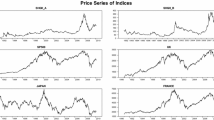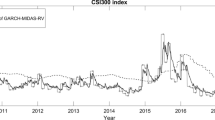Abstract
In this paper, we examine the nature of transmission of stock returns and volatility between the U.S. and Japanese stock markets using futures prices on the S&P 500 and Nikkei 225 stock indexes. We use stock index futures prices to mitigate the stale quote problem found in the spot index prices and to obtain more robust results. By employing a two-step GARCH approach, we find that there are unidirectional contemporaneous return and volatility spillovers from the U.S. to Japan. Furthermore, the U.S.'s influence on Japan in returns is approximately four times as large as the other way around. Finally, our results show no significant lagged spillover effects in both returns and volatility from the Osaka market to the Chicago market, while a significant lagged volatility spillover is observed from the U.S. to Japan.
Similar content being viewed by others
References
Aggarwal, R. and Park, Y.S. (1994), The relationship between daily U.S. and Japanese equity prices: Evidence from spot versus futures markets, J. Banking Finance 18, 757-773.
Bae, K.H. and Karolyi, A.G. (1994), Good news, bad news and international spillovers of stock return volatility between Japan and the U.S., Pacific-Basin Finance J. 2, 405-438.
Becker, K.G., Finnerty, J.E., and Tucker, A.L. (1992), The intraday interdependence structure between U.S. and Japanese equity markets, J. Financ. Res. 15(1), 27-37.
Becker, K.G., Finnerty, J.E., and Tucker, A.L. (1993), The overnight and daily transmission of stock index futures prices between major international markets, J. Busin. Account. 20, 699-710.
Booth, G.G., Lee, T.-H., and Tse, Y. (1996), International linkages in Nikkei stock index futures markets, Pacific-Basin Finance J. 4, 59-76.
Bollerslev, T., Chou, R.Y., and Kroner, K. (1992), ARCH modeling in finance: A selective review of the theory and empirical evidence, J. Econometrics 52, 5-59.
Boudoukh, J., Richardson, M., and Whitelaw, R. (1994), A tale of three schools: Insights on autocorrelations of short-horizon stock returns, Rev. Financ. Stud. 7, 539-573.
Chan, K. (1992), A further analysis of the lead-lag relationship between the cash market and stock index futures market, Rev. Financ. Stud. 5, 123-152.
Errunza, V. and Losq, E. (1985), The behavior of stock prices on LDC markets, J. Banking Finance 9, 561-575.
Eun, C. and Shim, S. (1989), International transmission of stock market movements, J. Financ. Quantitat. Anal. 24, 241-256.
Glosten, L.R., Jagannathan, R., and Runkle, D.E. (1993), On the relation between the expected value and the volatility of the nominal excess return on stocks, J. Finance 68, 1779-1801.
Hamao, Y., Masulis, R., and Ng, V. (1990), Correlations in price changes and volatility across international stock markets, Rev. Financ. Stud. 3, 281-308.
Kawaller, I.G., Koch, P.D., and Koch, T.W. (1993), Intraday market behavior and the extent of feedback between S&P 100 futures prices and the S&P 500 index, J. Financ. Res. 16, 107-121.
Kim, C. and Park, J. (1994), Holiday effect and stock returns: Further evidence, J. Financ. Quantitat. Anal. 29, 45-157.
King, M. and Wadhwani, S. (1990), Transmission of volatility between stock markets, Rev. Financ. Stud. 3, 5-33.
Lin, W., Engle, R., and Ito, T. (1994), Do bulls and bears move across borders? International transmission of stock returns and volatility, Rev. Financ. Stud. 7, 507-538.
Newey, W. and West, K. (1987), A simple positive-definite heteroskedasticity and autocorrelation consistent covariance matrix, Econometrica 55, 703-708.
Ross, S. (1989), Information and volatility: The no-arbitrage martingale approach to timing and resolution irrelevancy, J. Finance 44, 1-17.
Scholes, M. and Williams, J. (1977), Estimating betas from nonsynchronous data, J. Financ. Econom. 5, 309-327.
Stoll, H. and Whaley, R. (1990), The dynamics of stock index and stock index futures returns, J. Financ. Quantitat. Anal. 25, 441-468.
Susmel, R. and Engle, R.F. (1994), Hourly volatility spillovers between international equity markets, J. Int. Money Finance 13, 3-25.
Theodossiou, P. and Lee, U. (1993), Mean and volatility spillovers across major national stock markets: Further empirical evidence, J. Finance Res. 16, 337-350.
von Furstenberg, G. and Jeon, B. (1989), International stock price movements: Links and messages, Brookings Papers on Economic Activity 1, 125-167.
Author information
Authors and Affiliations
Rights and permissions
About this article
Cite this article
Pan, MS., Hsueh, L.P. Transmission of Stock Returns and Volatility between the U.S. and Japan: Evidence from the Stock Index Futures Markets. Asia-Pacific Financial Markets 5, 211–225 (1998). https://doi.org/10.1023/A:1010000606092
Issue Date:
DOI: https://doi.org/10.1023/A:1010000606092




